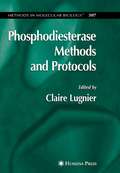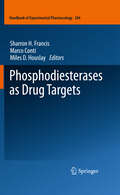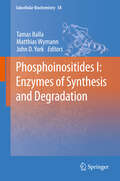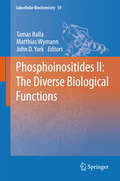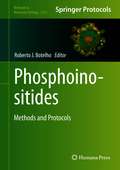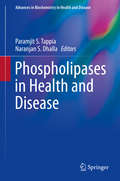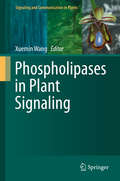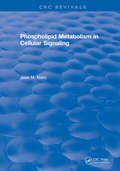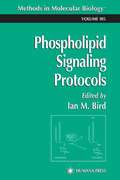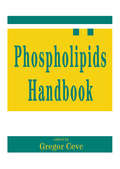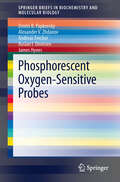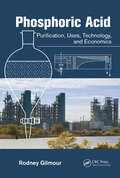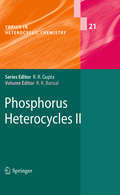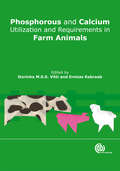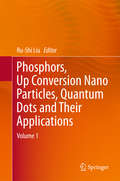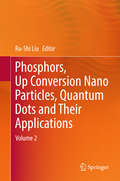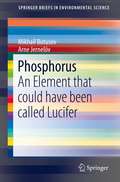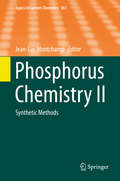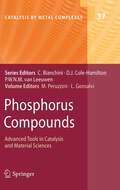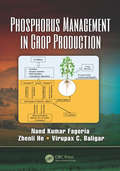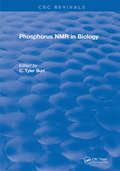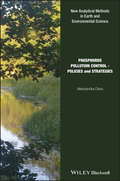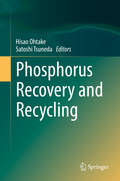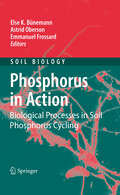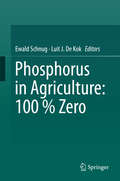- Table View
- List View
Phosphodiesterase Methods and Protocols
by Claire LugnierResearch leaders in the PDE field describe new concepts and techniques for investigating the role of PDEs in orchestrating normal and pathophysiological responses. Presented in step-by-step detail, these readily reproducible methods allow the measurement of cyclic nucleotide variations in living cells, as well as their visualization in a spatio-temporal manner, the localization and characterization of their activities in tissues and living cells, and the assessment of targeted PDEs in creating specific tools and drugs. Additional chapters discuss the generation of PDE4 knockout mice to demonstrate not only the potential role of targeted PDEs, but also their use in further studies of the central role of PDE regulation in intracellular signaling control. These techniques offer clinicians a way to find new therapies for numerous pathologies whose molecular origins are unknown and whose treatment is symptomatic. Alterations of intracellular signaling related to PDE deregulation in such pathologies as inflammation, neurodegeneration, and cancer may explain the difficulties observed in their prevention and treatment.
Phosphodiesterases as Drug Targets
by Marco Conti Miles D. Houslay Sharron H. FrancisCyclic nucleotide phosphodiesterases (PDEs) are promising targets for pharmacological intervention. Multiple PDE genes, isoform diversity, selective expression and compartmentation of the isoforms, and an array of conformations of PDE proteins are properties that challenge development of drugs that selectively target this class of enzymes. Novel characteristics of PDEs are viewed as unique opportunities to increase specificity and selectivity when designing novel compounds for certain therapeutic indications. This chapter provides a summary of the major concepts related to the design and use of PDE inhibitors.
Phosphoinositides I: Enzymes of Synthesis and Degradation
by Matthias Wymann John D. York Tamas BallaPhosphoinositides play a major role in cellular signaling and membrane organization. During the last three decades we have learned that enzymes turning over phosphoinositides control vital physiological processes and are involved in the initiation and progression of cancer, inflammation, neurodegenerative, cardiovascular, metabolic disease and more. In two volumes, this book elucidates the crucial mechanisms that control the dynamics of phosphoinositide conversion. Starting out from phosphatidylinositol, a chain of lipid kinases collaborates to generate the oncogenic lipid phosphatidylinositol(3,4,5)-trisphosphate. For every phosphate group added, there are specific lipid kinases - and phosphatases to remove it. Additionally, phospholipases can cleave off the inositol head group and generate poly-phosphoinositols, which act as soluble signals in the cytosol. Volume I untangles the web of these enzymes and their products, and relates them to function in health and disease. Phosphoinositide 3-kinases and 3-phosphatases have received a special focus in volume I, and recent therapeutic developments in human disease are presented along with a historical perspective illustrating the impressive progress in the field.
Phosphoinositides II: The Diverse Biological Functions
by Matthias Wymann John D. York Tamas BallaPhosphoinositides play a major role in cellular signaling and membrane organization. During the last three decades we have learned that enzymes turning over phosphoinositides control vital physiological processes and are involved in the initiation and progression of cancer, inflammation, neurodegenerative, cardiovascular, metabolic disease and more. In two volumes, this book elucidates the crucial mechanisms that control the dynamics of phosphoinositide conversion. Starting out from phosphatidylinositol, a chain of lipid kinases collaborates to generate the oncogenic lipid phosphatidylinositol(3,4,5)-trisphosphate. For every phosphate group added, there are specific lipid kinases - and phosphatases to remove it. Additionally, phospholipases can cleave off the inositol head group and generate poly-phosphoinositols, which act as soluble signals in the cytosol. Volume II extends into the role of phosphoinositides in membrane organization and vesicular traffic. Endocytosis and exocytosis are modulated by phosphoinositides, which determine the fate and activity of integral membrane proteins. Phosphatidylinositol(4,5)-bisphosphate is a prominent flag in the plasma membrane, while phosphatidylinositol-3-phosphate decorates early endosomes. The Golgi apparatus is rich in phosphatidylinositol-4-phosphate, stressed cells increase phosphatidylinositol(3,5)-bisphosphate, and the nucleus has a phosphoinositide metabolism of its own. Phosphoinositide-dependent signaling cascades and the spatial organization of distinct phosphoinositide species are required in organelle function, fission and fusion, membrane channel regulation, cytoskeletal rearrangements, adhesion processes, and thus orchestrate complex cellular responses including growth, proliferation, differentiation, cell motility, and cell polarization.
Phosphoinositides: Methods and Protocols (Methods in Molecular Biology #2251)
by Roberto J. BotelhoThis detailed book examines experimental approaches used to investigate the regulation and function of phosphoinositides (PtdInsP), rare eukaryotic phospholipids with a broad role in biological processes such as signal transduction, cell migration and adhesion, cell growth, subcellular organization, and membrane trafficking. The combination of complementary biochemical, mass spectrometry, and imaging methods are instrumental for the detection and quantification of PtdInsP species, as well as induced dimerization methods, affinity precipitation or co-sedimentation with liposomes, protein insertion within lipid bilayers, and enzymatic assays, or through emerging methods like native mass spectrometry and microfluidics, all of which are touched upon in this volume. Written in the highly successful Methods in Molecular Biology format, chapters include introductions to their respective topics, lists of the necessary materials and reagents, step-by-step, readily reproducible laboratory protocols, and tips on troubleshooting and avoiding known pitfalls. Authoritative and practical, Phosphoinositides: Methods and Protocols provides detailed methodology for both specialist and novice researchers on a variety of complementary methods that have been instrumental in dissecting the regulation, dynamics, and function of PtdInsPs.
Phospholipases in Health and Disease
by Naranjan S. Dhalla Paramjit S. TappiaPhospholipases generate lipid signaling molecules through their hydrolytic action on phospholipids and are known to regulate function of a variety of cells under normal and diseased conditions. While several physiological, biochemical and molecular techniques have identified key players involved in different disease processes, phospholipases have also emerged as critical players in the pathogenesis of a number of different diseases including cancer and heart disease. In addition, phospholipases are also implicated in such conditions as brain disorder/injury, kidney and immune cell dysfunction. Phospholipases in Health and Disease is a compilation of review articles dedicated to the study of the field with respect to biochemical and molecular mechanisms of normal and abnormal cell function. The wide range of area covered here is of interest to basic research scientists, clinicians and graduate students, who are engaged in studying pathophysiological basis of a variety of diseases. Furthermore, this book highlights the potential of the different phospholipases as therapeutic targets as well as part of prevention strategies. Twenty three articles in this book are organized in four sections that are designed to emphasize the most characterized forms of the phospholipases in mammalian cells. The first section discusses general aspect of phospholipases. Section two covers the role and function of phospholipase A in different pathophysiological conditions. The third section is focussed on phospholipase C which is believed to play a central role in transmembrane signaling. The final section covers phospholipase D which is present in a variety of different cells. The book illustrates that the activation of phospholipases is of fundamental importance in signal transduction affecting cell function. Overall, this book discusses the diverse mechanisms of phospholipase mediated signal transduction in different pathophysiological conditions and raises the possibility of specific forms of phospholipases serving as novel targets for drug development.
Phospholipases in Plant Signaling
by Xuemin WangThis volume focuses on recent advances in the biochemical and molecular analysis of different families of phospholipases in plants and their roles in signaling plant growth, development and responses to abiotic and biotic cues. The hydrolysis of membrane lipids by phospholipases produces different classes of lipid mediators, including phosphatidic acid, diacylglycerol, lysophospholipids, free fatty acids and oxylipins. Phospholipases are grouped into different families and subfamilies according to their site of hydrolysis, substrate usage and sequence similarities. Activating one or more of these enzymes often constitutes an early, critical step in many regulatory processes, such as signal transduction, vesicular trafficking, secretion and cytoskeletal rearrangements. Lipid-based signaling plays pivotal roles in plant stress responses, cell size, shape, growth, apoptosis, proliferation, and reproduction.
Phospholipid Metabolism in Cellular Signaling
by Jose M. MatoPhospholipids are no longer considered exclusively as the building blocks of biomembranes, but are now regarded to be exceptionally important to cellular signalling.Another conclusion resulting from studies over the past several years is that no single general scheme for the role of phospholipids during cell activation can be drawn as representative of all cells. This book presents a comprehensive view of the recent advances made in certain major research areas within the field of phospholipid metabolism in cellular signalling. Topics discussed within this volume include lipid composition of cellular membranes and their organization in biological systems, the dynamic aspects of phospholipid metabolism and its regulation by extracellular stimuli, and the role of newly discovered glycosyl-phosphatidylinositols in insulin action . The book also discusses two biologically active phospholipids: the sphingolipids, and ether-linked glycerophospholipids (the platelet activating factor). Phospholipid Metabolism in Cellular Signaling is an important research reference that should be considered required reading by all scientists and graduate students working on cell activation (e.g., growth factors, hormones, and oncogenes).
Phospholipid Signaling Protocols
by Ian BirdThis wide-ranging collection of state-of-the-art techniques for the assay of phospholipid and phospholipid-derived second messengers allows the identification and quantification of signal pathway activation. The assays described cover all the major phospholipases (C, D, A2), as well as sphingomyelinase and associated metabolites. Additional protocols are provided for the assay of phosphoinositide 3-, 4-, and 5-kinase activity and for the separation and identification of phospholipids, diacylglycerol and sphingolipids, as well as their phosphoinositol, choline, and fatty acid metabolites. Detailed, step-by-step instructions make this book suitable for both the newcomer and the experienced investigator.
Phospholipids Handbook
by Gregor CevcEmploying a multidisciplinary approach to phospholipid research, this work catalogues the current knowledge of this class of molecules and details the general, chemical, physical and structural properties of phospholipid monolayers and bilayers. Phospholipid applications are also covered.
Phosphorescent Oxygen-Sensitive Probes
by James Hynes Dmitri Papkovsky Ruslan I. Dmitriev Andreas Fercher Alexander V. ZhdanovBiological O2 sensing probes and measurement techniques were first introduced in the late 80s. In the last 3-5 years they have undergone major development that have made them available and affordable for a broad range of applications in various disciplines of the life and biomedical sciences. These new chemistries and technologies, which are significantly different from the majority of other fluorescence-based probes and detection techniques, have already demonstrated their high utility. This book will provide a systematic overview of the existing and emerging O2 sensing technologies in their different modifications, a practical guide to their rational selection and use, and examples of biological applications/case studies, including details on how to set up and conduct such experiments, troubleshoot and interpret the data.
Phosphoric Acid: Purification, Uses, Technology, and Economics
by Rodney GilmourThe rise and rationalization of the industrial phosphates industry have gone hand in hand with the development and maturation of technologies to purify phosphoric acid. In the 1960s and 70s, driven by the exponential sales growth of the detergent-builder sodium tripolyphosphate, chemical producers raced to develop processes that would provide a suf
Phosphorous and Calcium Utilization and Requirements in Farm Animals
by Ermias Kebreab Dorinha M. S. S. VittiThis book brings together quantitative aspects of phosphorus and calcium metabolism in farm animals in chapters written by leading researchers worldwide. It covers isotope dilution technique, phosphorus and calcium utilization in ruminants (sheep, goats and cattle) and non-ruminants (swine, horses) and recommended value of phosphorus and calcium inclusion in feed. It is an essential resource for researchers and students in animal sciences and nutrition.
Phosphors, Up Conversion Nano Particles, Quantum Dots and Their Applications
by Ru-Shi LiuThis book introduces readers to fundamental information on phosphor and quantum dots. It comprehensively reviews the latest research advances in and applications of fluoride phosphors, oxide phosphors, nitridosilicate phosphors and various quantum dot materials. Phosphors and phosphor-based quantum dot materials have recently gained considerable scientific interest due to their wide range of applications in lighting, displays, medical and telecommunication technologies. This work will be of great interest to researchers and graduate students in materials sciences and chemistry who wish to learn more about the principles, synthesis and analysis of phosphors and quantum dot materials.
Phosphors, Up Conversion Nano Particles, Quantum Dots and Their Applications
by Ru-Shi LiuThis book introduces readers to fundamental information on phosphor and quantum dots. It comprehensively reviews the latest research advances in and applications of fluoride phosphors, oxide phosphors, nitridosilicate phosphors and various quantum dot materials. Phosphors and phosphor-based quantum dot materials have recently gained considerable scientific interest due to their wide range of applications in lighting, displays, medical and telecommunication technologies. This work will be of great interest to researchers and graduate students in materials sciences and chemistry who wish to learn more about the principles, synthesis and analysis of phosphors and quantum dot materials.
Phosphorus
by Arne Jernelöv Mikhail ButusovThis book starts with depiction of the phosphorus role in life creation and evolution. Then it outlines in which vital processes different phosphates participate in life of all flora and fauna, from DNA molecules till body tissues. Crucial function of phosphates was noticed long ago, but only in XIX century discovery of mineral fertilizers made it possible to sustain the needs of growing global population, thus initiating a "green revolution". Though, for many decades after it, the complexity of interactions "fertilizer-soil-plant roots" was underrated, causing massive damages, such as soil destruction and eutrophication of waters. Still, mining of exhausting natural phosphate reserves continued worldwide. Lessons of what happened in XIX century due to scarcity of phosphates were ignored. In the meantime, production of phosphates reached its peak few years ago. Immediate implementation of phosphate recycling technologies from municipal wastes can help avoid imminent global disaster.
Phosphorus Chemistry I
by Jean-Luc MontchampEach review within the volume critically surveys one aspect of that topic and places it within the context of the volume as a whole. The most significant developments of the last 5 to 10 years are presented using selected examples to illustrate the principles discussed. The coverage is not intended to be an exhaustive summary of the field or include large quantities of data, but should rather be conceptual, concentrating on the methodological thinking that will allow the non-specialist reader to understand the information presented. Contributions also offer an outlook on potential future developments in the field.
Phosphorus Compounds
by Luca Gonsalvi Maurizio PeruzziniEach chapter of Phosphorus Compounds: Advanced Tools in Catalysis and Material Sciences have been carefully selected by the editors in order to represent a state-of-the-art overview of how phosphorus chemistry can provide solutions in various fields of applications. The editors have assembled an international array of world-renowned scientists and each chapter is written by experts in the fields of synthetic chemistry, homogeneous catalysis, dendrimers, theoretical calculations, materials science, and medicinal chemistry with a special focus on the chemistry of phosphorus compounds. Phosphorus Compounds: Advanced Tools in Catalysis and Material Sciences is of interest to a general readership ranging from advanced university course students to experts in academia and industry.
Phosphorus Management in Crop Production
by Nand Kumar Fageria Zhenli He Virupax C. BaligarThe world population is projected to reach nine billion by 2050, and in the coming years, global food demand is expected to increase by 50% or more. Higher crop productivity gains in the future will have to be achieved in developing countries through better natural resources management and crop improvement. After nitrogen, phosphorus (P) has more widespread influence on both natural and agricultural ecosystems than any other essential plant element. It has been estimated that 5.7 billion hectares of land worldwide contain insufficient amounts of available P for sustainable crop production, and P deficiency in crop plants is a widespread problem in various parts of the world. However, it has been estimated that worldwide minable P could last less than 40 years. For sustaining future food supplies, it is vital to enhance plant P use efficiency. To bring the latest knowledge and research advances in efficient management of P for economically viable and environmentally beneficial crop production in sustainable agriculture, Phosphorus Management in Crop Production contains chapters covering functions and diagnostic techniques for P requirements in crop plants, P use efficiency and interactions with other nutrients in crop plants, management of P for optimal crop production and environmental quality, and basic principles and methodology regarding P nutrition in crop plants. The majority of research data included are derived from many years of field, greenhouse, and lab work, hence the information is practical in nature and will have a significant impact on efficient management of P-fertilizers to enhance P use efficiency, improve crop production, promote sustainable agriculture, and reduce P losses through eluviations, leaching, and erosion to minimize environmental degradation. A comprehensive book that combines practical and applied information, Phosphorus Management in Crop Production is an excellent reference for students, professors, agricultural research scientists, food scientists, agricultural extension specialists, private consultants, fertilizer companies, and government agencies that deal with agricultural and environmental issues.
Phosphorus NMR in Biology
by C. BurtNMR is a technique that can spoil you. It is true that it is not as sensitive as some of the spectroscopic methods, but the quality of the information and the incredible ease of sample preparation make it one of the tools that have opened new vistas in biological research. This volume is intended to show how those vistas can range from the molecule to the microbe to man himself. Further, it is what prompts the rather broad title.
Phosphorus Pollution Control: Policies and Strategies (Analytical Methods in Earth and Environmental Science)
by Aleksandra DrizoPhosphorus Pollution Control – Policies and Strategies Deterioration and decline of water resources due to pollution caused by humans and their activities has become a universal health, environmental, social and economic problem. Excess discharges of nutrients, in particular, phosphorus, has been recognized as the most prevalent water pollution problem globally. Moreover, its perpetual occurrence and expansion creates imminent threats to water and food security. Despite extensive research during the past five decades, many key questions in eutrophication science remain unanswered. This book summarizes the most recent policies and strategies for phosphorus removal and recovery from municipal, residential and agricultural wastewater effluents and runoff into a concise and up-to-date volume. The book will be of interest to environmental and water resources scientists and engineers, consultants, policy makers, and practitioners working in the field.
Phosphorus Recovery and Recycling
by Hisao Ohtake Satoshi TsunedaThis book focuses on the engineering aspects of phosphorus (P) recovery and recycling, presenting recent research advances and applications of technologies in this important and challenging area of engineering. It highlights full-scale applications to illustrate the performance and effectiveness of the new technologies. As an essential element for all living organisms, P cannot be replaced by any other element in biochemical processes, humans ultimately rely its availability. Today, P is mostly obtained from mined rock phosphate (Pi). However, natural reserves of high-grade rock Pi are limited and dwindling on a global scale. As such, there have been increased efforts to recycle P from secondary sources, including sewage sludge, animal manure, food waste, and steelmaking slag, and so close the anthropogenic P cycle. In addition to various aspects of phosphorus covered by other literature, including chemistry, biochemistry, ecology, soil-plant systems and sustainable management, this book is a valuable and comprehensive source of information on the rapidly evolving field of P recovery and recycling engineering for students, researchers, and professionals responsible for sustainable use of phosphorus.
Phosphorus in Action
by Astrid Oberson Else K. Bünemann Emmanuel FrossardPhosphorus (P) is a finite resource which is essential for life. It is a limiting nutrient in many ecosystems but also a pollutant which can affect biodiversity in terrestrial ecosystems and change the ecology of water bodies. This book collects the latest information on biological processes in soil P cycling, which to date have remained much less understood than physico-chemical processes. The methods section presents spectroscopic techniques and the characterization of microbial P forms, as well as the use of tracers, molecular approaches and modeling of soil-plant systems. The section on processes deals with mycorrhizal symbioses, microbial P solubilization, soil macrofauna, phosphatase enzymes and rhizosphere processes. On the system level, P cycling is examined for grasslands, arctic and alpine soils, forest plantations, tropical forests, and dryland regions. Further, P management with respect to animal production and cropping, and the interactions between global change and P cycling, are treated.
Phosphorus in Agriculture: 100 % Zero
by Ewald Schnug Luit J. De KokThe title 'Phosphorus in Agriculture: 100 % Zero' is synonymous for make-or-break. And it stands up to the promise. This book sends an important message as it delivers background information, intrinsic hypotheses, validation approaches and legal frameworks, all for balanced phosphorus fertilization in agriculture. This implies firstly that the phosphorus requirement of crop is fully satisfied by applying exclusively fertilizers which contain the nutrient in completely available form. Secondly, environmental demands through eutrophication and hazardous contaminants must not be compromised. The book identifies equally knowledge gaps and deficits in the transformation and implementation of research into practice. Bottom line is that research delivers the tools for a sustainable phosphorus management while legal frameworks are insufficient.
